Accessibility Options:
Keys to the Displays at Richter Library
Throughout April and May, the University of Miami Libraries presents Origins and Influence, an exhibition commemorating Asian American and Pacific Islander Heritage Month. Featured on the first and second floors of the library, the exhibit illustrates the many ways in which Asia has become mainstream in America.
Choose the corresponding tabs above to find out more information. Each tab represents a display case or wall display.
Welcome to Asia: A rare Japanese design scrapbook and a selection of Asian themed items from the Pan American World Airways, Inc. Records, housed in our Special Collections Department
AASA: This case is on the Asian American Students Association of the University of Miami. It contains images of the members and their activities with emphasis on the annual Lunar New Year Celebration held on the Coral Gables Campus.
Anime and Manga: A collection of popular and critically acclaimed anime and manga series.
Immigration: This case represents stories of immigration from Asia to the United States and Asian identity in America.
Cinema: This case features a selection of films chronicling the career of New Zealand director Peter Jackson, three Asian films remade by American and Italian studios, and a film adaptation of a surreal Japanese fairytale.
Food: This case displays the influence of Asian food on American culture.
Clothing: This case is on traditional Asian attire. The characteristics of the Chinese, Japanese, and Korean ethnic dresses are shown from the books on the subject from the University of Miami Libraries’ collection.
Murakami: This case is on Haruki Murakami, who is from Japan, and is one of the best-known authors in world literature today.
Origins and Influence

Pan Am’s World Tours: Asian-Pacific Travel (1927-1991)
From Pan Am’s founding in 1927 through its closing in 1991, the airline served as an international leader in aviation and was a pioneer in the development of airplane design and technology, air routes, commercial passenger service, navigation techniques, and communication systems. Items showcased from the collection include official brochures, photographs, menus, and ephemera.
Items included are from the holdings of the Pan American World Airways, Inc. Records, University of Miami Libraries Special Collections.
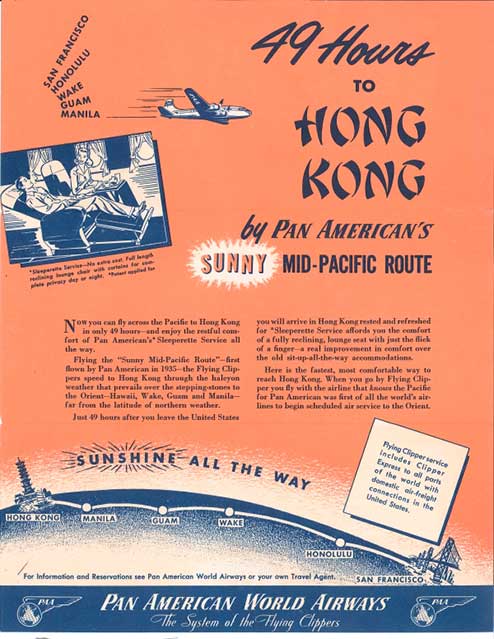
Located in the Richter Library Lobby
A 1954 Japanese travel brochure with prices and daily agendas for tours from two to fourteen days.
An on-flight menu for Pan Am air service to New Zealand. The Rainbow Service breakfast menu features grilled link sausages and scrambled eggs. Beverage options include Japanese green tea and orange pekoe tea
 Buddha of Beppu is Largest in Japan
Buddha of Beppu is Largest in JapanThe largest Buddha in Japan stands in the port city of Beppu on the eastern coast of the island of Kyushu. This concrete giant, towering 86 feet above the ground, is almost three feet taller than the famous Great Buddha of Nara. The colossus was built, so they say, by a wealthy Japanese money-lender, who found a cure for his ills at the hot springs of Beppu.
Ginza Rivals Times Square
The Ginza, gaudy heartline of downtown Tokyo with its blazing neon signs and tiny lantern-lit alleys, rivals the razzle-dazzle flow of Broadway by night. The street by day is a ribbon of modernity, lined with smart shops, restaurants, and theaters, catering to both Western and Oriental tastes.

Japan: ca. 1900
This unique scrapbook contains a wonderful collection of Japanese traditional motifs – such as animals, flowers, and landscapes – that were used in the design of women’s accessories and other small decorative objects. The illustrations were hand-painted on rice paper, then pasted on the pages of the scrapbook.
Assumed to be from the personal collection of an unidentified craftsman who made combs and hand mirrors in the early Meiji period, the exact creation date of the scrapbook is unknown.
Asian American Students Association at the University of Miami

AASA members after the 2014 Lunar New Year Celebration.
On February 3, 2014, hundreds of students, faculty, staff, and visitors gathered to celebrate the Third Annual Lunar New Year Celebration at the University Center Patio with a dragon dance, cultural performances, and interactive activities. Hosted by the Asian American Students Association and the Chinese Students and Scholars Association since 2012, this festive event has become a popular new tradition for the University of Miami community.
Established in 1977, the Asian American Students Association (AASA) at the University of Miami promotes the awareness of Asian culture and the Asian American identity. Their goal is to build unity and strengthen communication among Asian and Asian American students, while educating the University community about their cultures and traditions.
AASA provides wonderful programs for University of Miami students to connect cross-culturally and for the student body to learn more about Asian culture. The organization welcomes all to participate in their social and cultural events. It is a great example of how active student groups are on campus, and how the Asian culture is embraced in the university community.
Located at Richter Library, 1st floor
Photographs on display are courtesy of University Communications and AASA.

Dragon Dance at UM
The dragon dance is a traditional dance performed in festive celebrations, such as Chinese New Year. It is performed by a team of dancers who manipulate a long flexible figure of a dragon using poles. The dragon is a legendary symbol of China, and it is believed to bring good luck to people. It is believed that the longer the dragon dances the more luck it will bring to the community.
Lunar New Year Celebration (part 1)
· Two girls wearing Chinese hats and admiring the Chinese dolls.
· Calligraphy demonstration.
· Tea tasting.
· President Shalala was the guest of honor at the 2013 Celebration.
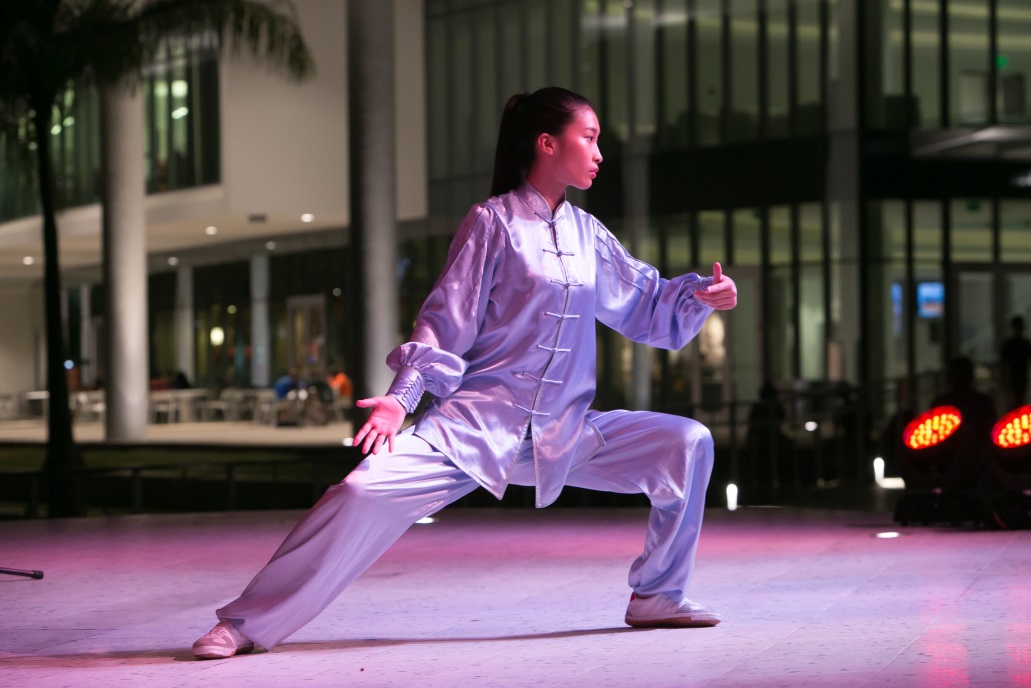
Lunar New Year Celebration (part 2)
· Guests enjoyed the delicious Chinese food.
· Kung Fu demonstration.
· Chinese Opera performance.
· Lion Dance performance.

Dragon Boat Races in Miami
In ancient China, the Dragon Boat was used for appeasing the rain gods. Later the people began to organize Dragon Boat Races to commemorate sacrifice of a great warrior poet, Qu Yuan, who committed suicide as a protest against the political corruption of the day. Since that time over 2000 years ago, Dragon Boat Racing has become a major part of Chinese culture, representing patriotism and group integrity. The South Florida Dragon Boat Festival in Miami has been celebrated since 2003.
Asian Culture Celebrated at UM throughout the Year
· Canefest
· Japanese tea ceremony demonstration
· Group outing on the Gandhi Day of Service
· End of the year banquet
UM Anime Club
What is anime? Why does it have a club?
Taken from the English word “animation,” anime is the art of Japanese animation. Anime can be in the form of either movies or television shows; it encompasses a wide range of genres and is developed for audiences both young and old. Immensely popular in Japan, anime has become a worldwide phenomenon, with fans on every continent. There are even fans here at the University of Miami, and they’ve banded together to form the UM Anime Club.
Every week, the UM Anime Club comes together to discuss Japanese culture, and, of course, watch anime. But there’s more to the club than just sitting together and enjoying anime and other live-action Japanese films. Members attend local comics and anime conventions together and host charity events, such as video game marathons whose proceeds go to the Miami Children’s Hospital.
Each year, the UM Anime Club hosts the Miami Hurricon, an anime convention for local fans featuring performances by UM student bands, panels discussing anime and Japanese culture, and special guests involved in the anime industry
Located at Richter Library
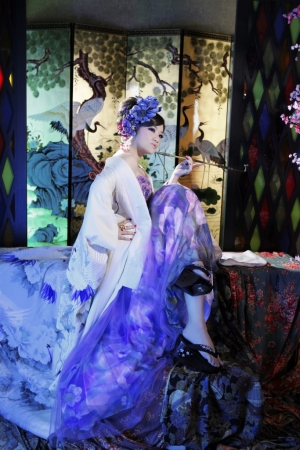 Character Type: Original Character in Japanese Fantasy Style
Character Type: Original Character in Japanese Fantasy StyleCosplay isn’t only about reproducing costumes identical to those in anime and manga series – “play” is important too. Some cosplayers create original characters with original costume designs based on mythology, history, popular fashion trends, or personal interests. This cosplay by Isabel Liu is meant to invoke a traditional Japanese kimono but with a fantasy theme.
Photography by Magic Studio.
 Character Type: Original Character in Japanese Goth-Loli Style
Character Type: Original Character in Japanese Goth-Loli StyleThough most costumes derive from anime and manga series, some of the “costume play” evolves from Japanese fashion trends. The “Gothic and Lolita” style of clothing – or “Goth-Loli” – is reminiscent of an American costuming trend known as “Steampunk.” Goth-Loli costumes evoke a modernized and somewhat fantastical reinterpretation of Victorian-era clothing.
Cosplay design by Isabel Liu. Photography by Magic Studio.
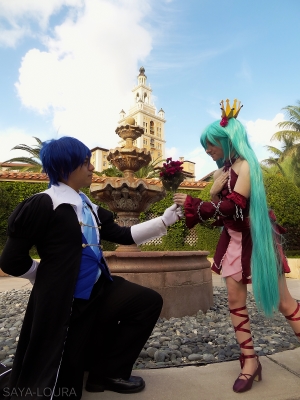 Character Names: Miku and Kaito
Character Names: Miku and KaitoOrigin: Vocaloid
Creating a good costume takes time, energy, planning and a great deal of imagination. Cosplay ideas can come from a variety of diverse sources: anime or manga from Japan, movies or video games from America. There are even cosplays of virtual characters from Japanese musical synthesizing software such as this cosplay of Miku and Kaito from Vocaloid.
Cosplay designs by Jacqueline Fisher and Daniel Nanetti-Palacios. Photography by Jacque
Located at Richter Library, 1st floor
Taken from the words “costume” and “play,” cosplay is the Japanese art of creating costumes, a tradition that has grown popular in the United States.
Cosplays can be done with characters from any anime, manga, video games, or movies. As cosplay has become more common and popular in the United States, characters from American comics, games, and movies have also become a common sight on comic book convention floors. Some cosplays are very simple; others extremely complex, taking many weeks and a great deal of planning and effort to complete.
The images in this cosplay series are provided by the University of Miami Anime Club.
Case contents - click on the images to view a larger, higher-resolution version.
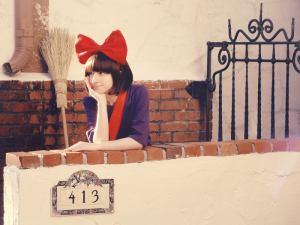 Character Name: Kiki
Character Name: KikiOrigin: Kiki’s Delivery Service
In Japan and among American fans of Japanese anime, costumes are usually created by cosplayers as replicas of clothing worn by different characters. This cosplay of Kiki, from the famous anime movie Kiki’s Delivery Service, is a simple but movie-accurate replica of Kiki’s costume. Replications of costumes are meant to be as accurate and detailed as possible. Since Kiki is a witch who uses her magic of flight to start her own delivery service, the broom leaning against the wall behind her is a subtle but important part of this cosplay.
Cosplay design and photography by Jacqueline Fisher.
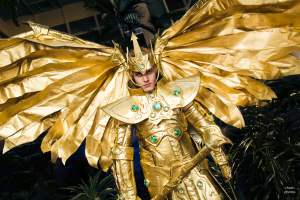 Character Name: Aioros
Character Name: AiorosOrigin: Saint Seiya
Anime characters often have elaborate clothing and hairstyles that are challenging to reproduce. Accuracy is always key to a good cosplay, and it often takes cosplayers many hours to hand-build each part of their costume from scratch. The more unique and complex a costume is, the more planning and time it takes for a good execution. This winged and highly detailed armor worn by the character Aioros from the anime Saint Seiya would have to be custom built by a cosplayer due to its complexity.
Cosplay design by Jonathan Stryker. Photography by Chasis Photos.
 Character Name: Link
Character Name: LinkOrigin: Legend of Zelda
Though many cosplays are based off of characters in anime or manga, video game characters are also common choices. The Legend of Zelda, a well-known video game franchise, is originally a Japanese creation. Cosplays of Link, the iconic hero of the game, are a popular choice.
Cosplay design by Jacqueline Fisher. Photography by Travis Photography.
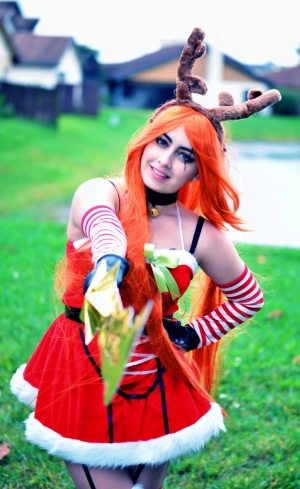 Character Name: Slaybelle Katrina
Character Name: Slaybelle KatrinaOrigin: League of Legends
Cosplay does not have to be based exclusively off of Japanese source material. As the popularity of cosplay has spread to the United States and the rest of the world, American cosplayers have used American source material for their costumes as well. League of Legends is an online multiplayer game of American origin, with costumed characters that can be used in cosplay, such as in this portrayal of Slaybelle Katrina by Hyemi Chu.
Cosplay design by Hyemi Chu. Photography by Hyemi Chu Photography.
 Character Name: Jack Frost
Character Name: Jack FrostOrigin: Rise of the Guardians
Animation is not an art form exclusive to Japan. Along with American video games, American cosplayers also create costumes based on American movies and animations. This cosplay reproduces the costume worn by Jack Frost in the movie Rise of the Guardians by DreamWorks Animation.
Cosplay design by Duy Truong. Photography by Sabrina Martinez and Duy Truong.
What are anime and manga?
Anime is the Japanese art of animation. “Anime,” taken from the English word “animation,” covers a wide variety of genres, including fantasy, science fiction, history, and romance. Some anime and manga series are geared towards young audiences, while others are intended for teenagers or adults. Though gritty dystopian movies such as Ghost in the Shell or Akira will primarily feature grungy settings and grimly hued artwork, most anime series are hallmarked by their bright colors. Pink, blue, or green hair is common for anime characters, along with wild hairstyles, enormous eyes, and a tendency towards cuteness.
Manga is anime’s printed counterpart: Japanese comic books. Like anime, manga appeals to a broad range of audiences, from children to adults. Most anime series are based off of manga, much like movies can be based off of books. Unlike American comic books, which are dominated by superheroes and full color pages, manga is usually printed in black and white and are filled with stories both with superheroes and without. You’re just as likely to find a superhero in a manga as you are a romantic comedy with completely ordinary people.
Additional Reading
Anime Anyone?
Located at Richter Library, 1st floor
 Nausicaa of the Valley of the Wind
Nausicaa of the Valley of the WindHayao Miyazaki
Tokyo: Tokuma Shoten, 1982-1994; Studio Ghibli, 1984
Nausicaa of the Valley of the Wind heralded the arrival of one of the world’s greatest animation producers and directors, Hayao Miyazaki. Published in print between 1982 and 1994, then made into a movie in 1984, Nausicaa provided Miyazaki with the success he needed to found the now-famous animation house, Studio Ghibli. Taking place in a dangerous post-apocalyptic world, Nausicaa tells the story of a courageous girl seeking to reconcile warring countries with an Earth just beginning to recover from ecological catastrophe.
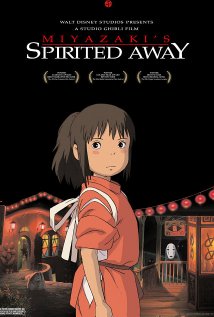 Spirited Away
Spirited AwayHayao Miyazaki
Tokyo: Studio Ghibli, 2001
One of Studio Ghibli’s most critically acclaimed productions, Spirited Away brings Alice in Wonderland to mind – the heroine, Chihiro, finds herself magically transported into a fantastical realm filled with witches, dragons, and other dangerous mythical creatures. Spirited Away continued the critical and popular success of Studio Ghibli’s earlier works, such as Princess Mononoke (1997) and My Neighbor Totoro (1988). More recent works, such as Ponyo (2008), Howl’s Moving Castle (2004), and The Secret World of Arrietty (2010), have continued Studio Ghibli’s tradition of excellence in animation.
Located at Richter Library, 1st floor
Sailor Moon
Naoko Takeuchi
Tokyo: Kodansha, 1992-1997
Sailor Moon was one of the earliest anime and manga series to achieve commercial success in the United States. Following the adventures of a middle school girl named Usagi – who happens to also be the reincarnation of the Princess of the Moon – Sailor Moon blended the magical girl genre with an already established tradition of superhero teams in Japanese comics. With international success in both manga and anime, Sailor Moon branched out into a series of stage musicals and a live action series. A reboot of the anime, claiming closer faithfulness to the manga, will begin in summer 2014.
Metropolis
Osamu Tezuka
Tokyo: Madhouse, 2001
Like many anime, Metropolis began as a manga. Originally published in 1949 and written by Osamu Tezuka, one of anime and manga’s most important figures, Metropolis, was adapted into an anime in 2001. Taking place in a future world where robots live alongside humans, Metropolis addresses complex issues such as class warfare and what it means to be human. Tezuka’s success with Metropolis was followed by other, now-classic manga series, including Astro Boy (1952-1968), Kimba the White Lion (1950-1953), Princess Knight (1953-1956), and Black Jack (1973-1983).
 Japanese Animation: From Painted Scrolls to Pokémon
Japanese Animation: From Painted Scrolls to PokémonBrigitte Koyama-Richard
Paris: Flammarion, 2010
Ukiyo-e, a form of woodblock printing, is one of Japan’s most traditional and beloved art forms. Dating back to the seventeenth century, ukiyo-e prints could include images ranging from scenes of domestic tranquility to kabuki actors and scenes from mythology. As time moved on and new technologies created new forms of entertainment, Japanese artists began to light up their works of ukiyo-e art with projectors, turning static works of art into works of the theater. Image projectors, such as magic lanterns, served as a transitional technology, bridging the static past to the motion-picture future. While audiences enjoyed the illuminated imagery, narrators supplemented the visuals with stories.
True animation, with characters that moved and spoke, were inevitable as cinematic technology continued to grow. Western production teams began founding world famous animation studios such as Disney. One of Japanese television’s earliest successful anime series – Astro Boy – was created by Osamu Tezuka and featured the adventures of a robot named Atom. A quick glance at Atom shows some remarkable physical similarities to Disney’s widely recognizable Mickey Mouse.
The anime and manga of today only superficially resemble their painted-scroll and woodblock print pasts, but scratch the surface and a rich history of Japanese art emerges behind them.
Rush to America: Asian Immigration and Identity
The items in this case represent stories of immigration from Asia to the United States, from Chinese who arrived with the California Gold Rush and laid the tracks for the transcontinental railroad, to the Vietnamese who emigrated from their homeland to escape political and economic strife. Asians coming to the United States set up enclaves that catered to their home communities, but they also immersed themselves in American culture. The struggle for identity in America is a common fight among immigrant communities.
Located at Richter Library, 1st floor
The Chinese in America: A Narrative History
Iris Chang
New York: Viking, 2003
A chronicling of the Chinese in America over the past 150 years. Shown are Chinese and Chinese Americans who are known for their significant cultural, political, and scientific contributions.
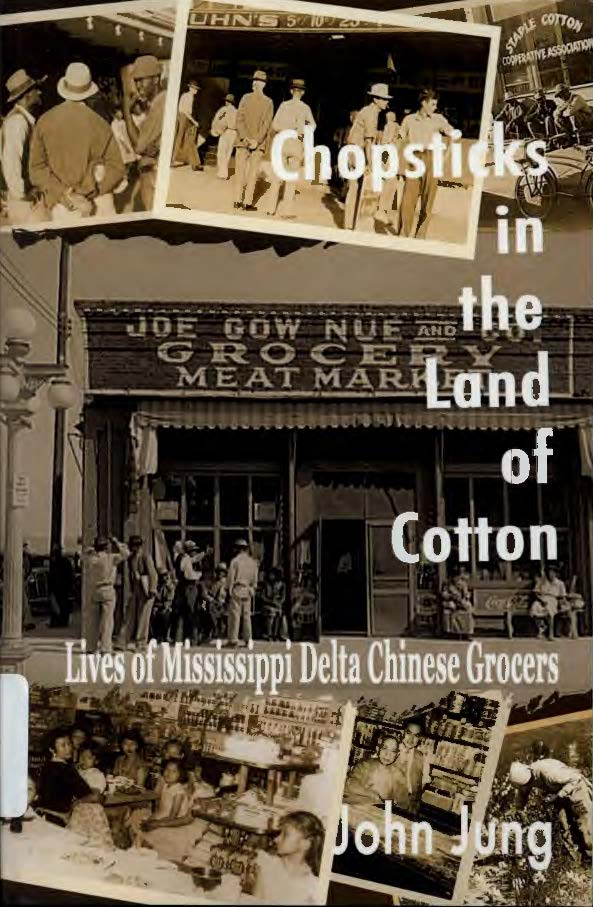 Chopsticks in the Land of Cotton: Lives of Mississippi Delta Chinese Grocers
Chopsticks in the Land of Cotton: Lives of Mississippi Delta Chinese GrocersJohn Jung
California: Ying and Yang Press, 2008
Arriving in the Mississippi Delta in the late 1870s, Chinese immigrants opened small family grocery stores. These families had an entirely different experience from those immigrating to larger coastal cities. In the South these Chinese immigrants had to find a social and political space in a deeply segregated community.
Native Speaker
Chang-rae Lee
New York: Riverhead Books, 1995
 The Four Immigrants Manga : A Japanese Experience in San Francisco, 1904-1924
The Four Immigrants Manga : A Japanese Experience in San Francisco, 1904-1924Henry Yoshitaka Kiyama
Berkeley, CA: Stone Bridge Press, 1999
A recovered collection of comics originally published in San Francisco in 1931. The comics follow four Japanese men as they make lives for themselves in San Francisco at the beginning of the twentieth century.
Escape to Gold Mountain: A Graphic History of the Chinese in North America
David H. T. Wong
Vancouver, B.C.: Arsenal Pulp Press, 2012
A graphic history of Chinese immigrants and their descendants in North America over the last 150 years
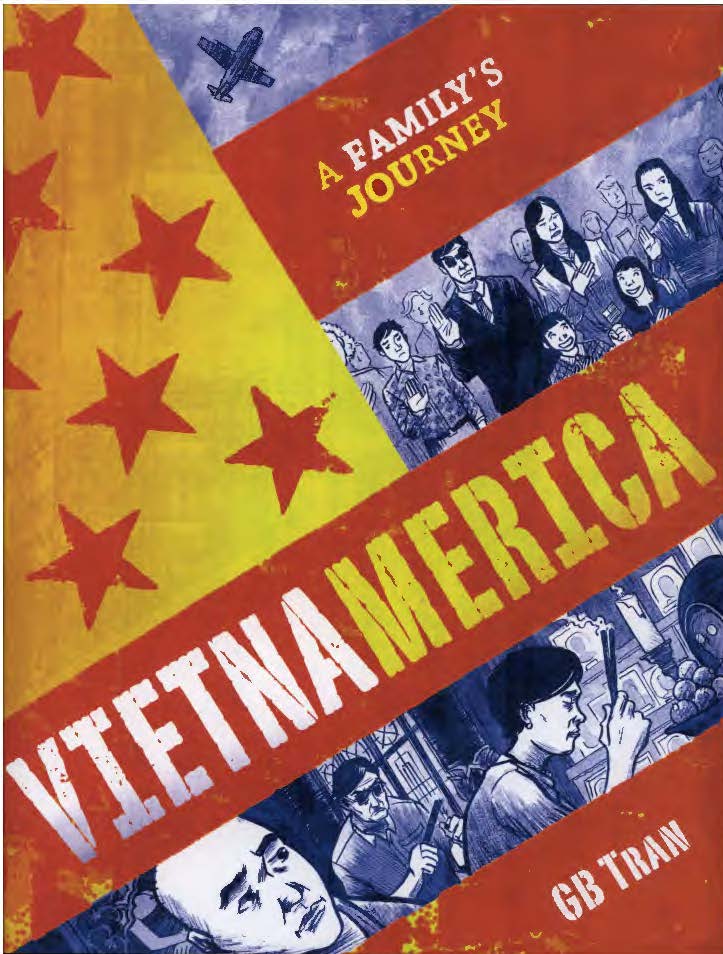 Vietnamerica: A Family’s Journey
Vietnamerica: A Family’s JourneyG. B. Tran
New York: Villard Books, 2010
A graphic memoir about artist G. B. Tran and his family’s immigration from Vietnam. Born and raised in South Carolina, the author goes to Vietnam in his late twenties to uncover the harrowing and heroic story of his family. .
East Meets West: Asian-Pacific Influence in Cinema
These Asian films garnered such international acclaim that they inspired American and Italian studios to use the source material for remakes, giving new filmmakers their chance to deliver a unique vision and allowing audiences to discover new appreciations of classic stories.
Located at Richter Library, 1st floor
 Oldboy
OldboyPark Chan-wook
South Korea: Show East, 2006
Oldboy
Spike Lee
USA: Forty Acres and a Mule/Filmworks, 2013
 Yojimbo
YojimboAkira Kurosawa
Japan: Toho Studios, 1961
A Fistful of Dollars
Sergio Leone
Italy: Constatin Film, 1964
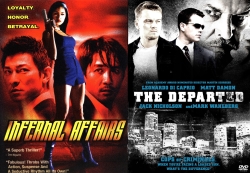 Infernal Affairs
Infernal AffairsWai-Keung Lau, Alan Mak
China: Media Asia Films, 2002
The Departed
Martin Scorsese
USA: Warner Bros., 2006
Asian food and cuisine has influenced American culture and palates. Asian cuisine has been ingrained in American culture for decades, although the foods that are experienced by Americans are not exactly the same as what is eaten in the countries of their origin. Asian food has been Americanized to a great degree and creates fusion between cultures.
Located at Richter Library, 2nd floor
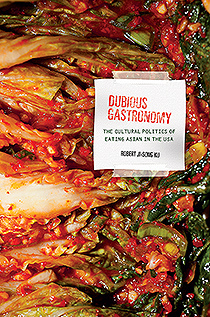 Dubious Gastronomy: The Cultural Politics of Eating Asian in the USA
Dubious Gastronomy: The Cultural Politics of Eating Asian in the USARobert Ji-Song Ku
Honolulu: University of Hawaii Press, 2014
A critical look at the authenticity of Asian food in the United States. This chapter discusses the presence of SPAM in Hawaiian cuisine and its move into Korean culture.
Chop Suey: A Cultural History of Chinese Food in the United States
Andrew Coe
New York: Oxford University Press, 2009
From the arrival of the first Chinese in America in 1784, Chinese food has made its way into the fabric of the United States. This is the cultural history of the presence of Chinese food in America.
 The Fortune Cookie Chronicles: Adventures in the World of Chinese Food
The Fortune Cookie Chronicles: Adventures in the World of Chinese FoodJennifer 8. Lee
New York: Twelve, 2009
There are more Chinese restaurants than McDonald’s in America. Lee presents the idea that Chinese food is more American than apple pie. This is a look at how tied Chinese food is tied not only to the Chinese American experience, but to American culture as a whole.
Eating Asian America: A Food Studies Reader
New York: New York University Press, 2013
Scholarly selections that dissect how Asian Americanness is represented in the American kitchen and discuss the impact of these culinary practices and ideas on gender, class, ethnicity, etc.
America Eats Out: An Illustrated History of Restaurants, Taverns, Coffee Shops, Speakeasies, and Other Establishments that Have Fed Us for 350 Years
John Mariani
New York: Morrow, 1991
Chinese food restaurants began in enclaves throughout the country, but they later spread to outside areas. Asian food was once seen as adventurous, but American desire to eat out brought Asian cuisine into popularity.
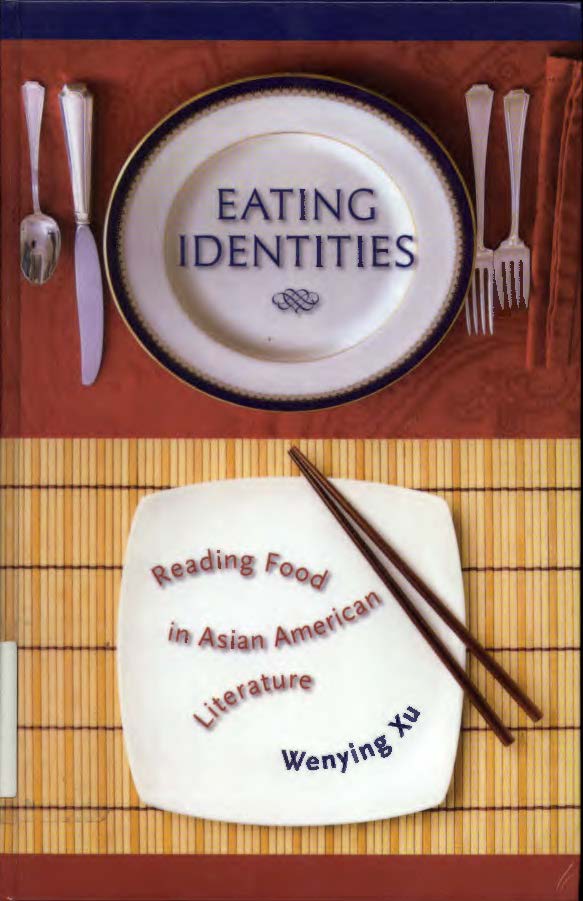 Eating Identities: Reading Food in Asian American Literature
Eating Identities: Reading Food in Asian American LiteratureWenying Xu
Honolulu: University of Hawaii Press, 2008
A cultural and sociological guide to food in Asian American literature. Dissecting the concept of “you are what you eat” as it pertains to food in Asian American writing.
Traditional Asian Attire
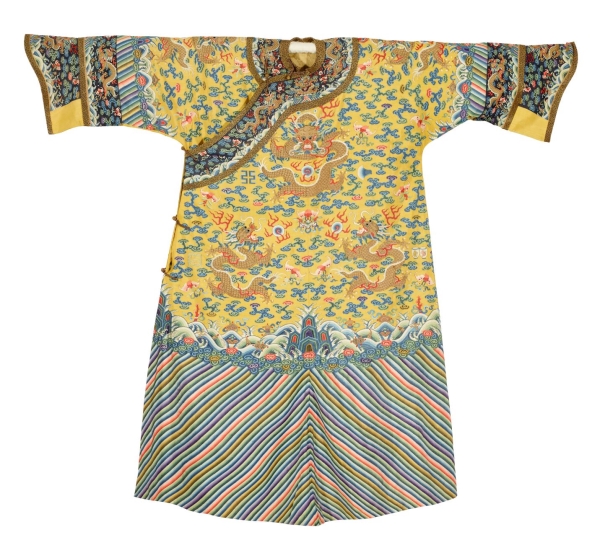
China, Qing Dynasty
Lowe Art Museum, University of Miami
Gift of Mr. and Mrs. C. Ruxton Love, 58.304.000
The people of Asia have a clothing tradition that is as rich and varied as that of the cultures of the West. East Asian garments generally open down the front and are worn like a coat because of the elaborate hairstyles and a range of hats worn by both men and women.
The characteristics of the T-shaped garments from the region are that the cut is closely related to the loom width of the fabric used. Kimonos from Japan, for example, are made of narrow pieces of fabric sewn together with the minimum of cutting.
Bast fibers, such as ramie and hemp were used in the earliest times. Silk, the great discovery of China approximately 5,000 to 8,000 years ago, was the material for the upper classes. Cotton, which was native to South Asia, was the daily clothing of the lower classes.
Located at Richter Library, 2nd floor
Silken Threads: A History of Embroidery in China, Korea, Japan, and Vietnam
Yong Yang Chung
New York: Harry N. Abrams, 2005
Chinese Dress: From the Qing Dynasty to the Present
Valery Garrett
Tokyo; Rutland, VT: Tuttle Publishing, 2007

Figure 100: Prince Chun II with his sons, the two-year-old Puyi (standing) and his younger brother Pujie (seated), all wearing informal short black jackets over long gowns, and skullcaps, ca. 1907.
Figure 103: Manchu princesses wearing banner gowns, the young girls flanking them by wearing waistcoats on top, ca. 1910.
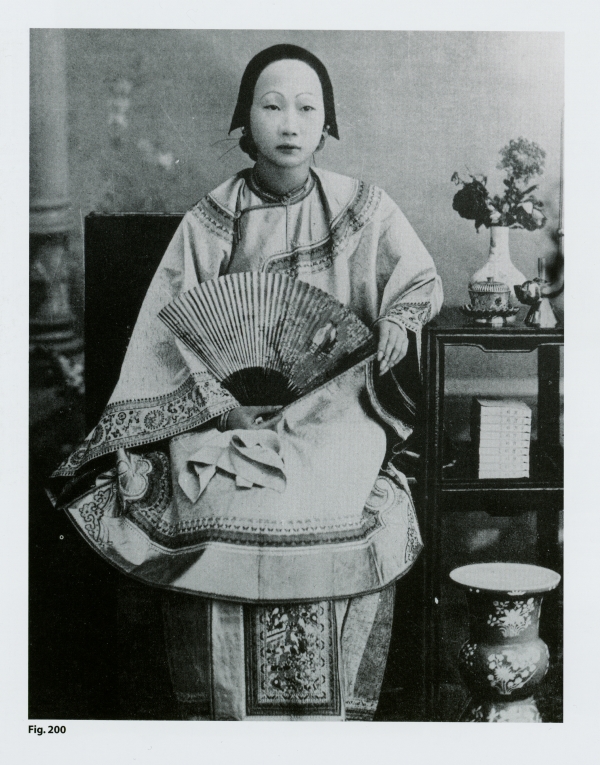
Figure 200: Woman wearing a semiformal jacket and folding a fan, nineteenth century.
Haruki Murakami
 ​
​Haruki Murakami is one of the best-known authors in the world of contemporary literature today. He debuted in 1979 with the novel Hear the Wind Sing, winning Japan’s prestigious Gunzo Literary Prize for New Authors. Since then, Murakami has written intriguing fictions and short stories, such as A Wild Sheep Chase (1982 in Japan and 1989 in the United States), Norwegian Wood (1987/2000), The Wind-up Bird Chronicle (1995/1997), After the Quake (2000/2002), Kafka on the Shore (2002/2005), and 1Q84 (2009/2011).
His works have been translated into more than forty languages, appeared on bestsellers lists across Asia, Europe, and the Americas, and have received numerous awards and recognitions, including Franz Kafka Prize (2006), Princeton University’s Doctor of Letters (2008), Jerusalem Prize (2009), and Orden de las Artes y las Letras de España (2009).
In the United States, all of Murakami’s major short stories and novels have been published by The New Yorker and Knopf since the early 1990s. He has sold over 2.5 million books in the United States alone, according to the 2011 article from BBC News Magazine, “Haruki Murakami: How a Japanese Writer Conquered the World” at the release of his then-latest work 1Q84 in Britain and the United States.
Murakami’s novels have become a very popular teaching material for world literature and comparative literature courses taught in the United States in recent years. Richter Library holds thirty titles of novels by him and literary criticism on his works by scholars (as of March 2014). His latest novel 1Q84 is available in print and electronically. His latest short story in English, Samsa in Love, is available free of charge at The New Yorker website. His new novel Colorless Tsukuru Tazaki and His Years of Pilgrimage, which was published in Japan in April 2013, will be available in the United States in August 2014.
Located at Richter Library, 2nd floor
 1Q84 (in English and Japanese)
1Q84 (in English and Japanese)An ode to George Orwell's "1984" told in alternating male and female voices relates the stories of Aomame, an assassin for a secret organization who discovers that she has been transported to an alternate reality, and Tengo, a mathematics lecturer and novice writer
After the Quake
In this adaptation of two of Haruki Murakami's brilliant short stories, Tony Award–winning director Frank Galati has fashioned an enchanting and deeply moving play that follows the lives of characters struggling with the aftermath of the 1995 earthquake in Kobe, Japan, that nearly destroyed the city. Rich in dreamlike imagery and haunting in its evocation of survival in the wake of terrible disaster, after the quake makes masterful use of storytelling to reveal and explore our primal fears.
 Blind Willow, Sleeping Women
Blind Willow, Sleeping WomenFrom the bestselling author of Kafka on the Shore and The Wind-up Bird Chronicles comes this superb collection of twenty-four stories that generously expresses Murakami's mastery of the form. From the surreal to the mundane, these stories exhibit his ability to transform the full range of human experience in ways that are instructive, surprising, and relentlessly entertaining. Here are animated crows, a criminal monkey, and an iceman, as well as the dreams that shape us and the things we might wish for. Whether during a chance reunion in Italy, a romantic exile in Greece, a holiday in Hawaii, or in the grip of everyday life, Murakami's characters confront grievous loss, or sexuality, or the glow of a firefly, or the impossible distances between those who ought to be closest of all. From the Trade Paperback edition.
 Rashomon and 17 Other Stories
Rashomon and 17 Other StoriesThis collection features a brilliant new translation of the Japanese master's stories with an introduction by Haruki Murakami. Akutagawa's disturbing tales of human passion capture the cultural upheaval of early twentieth century Japan, ranging from #147;In the Grove," the basis of Kurosawa's famous film Rashomon, to Akutagawa's later, more autobiographical writings.
The Japanization of Modernity: Murakami Haruki between Japan and the United States
Murakami Haruki is perhaps the best-known and most widely translated Japanese author of his generation. Despite Murakami’s critical and commercial success, particularly in the United States, his role as a mediator between Japanese and American literature and culture is seldom discussed.
Bringing a comparative perspective to the study of Murakami’s fiction,
Rebecca Suter complicates our understanding of the author’s oeuvre and highlights his contributions not only as a popular writer but also as a cultural critic on both sides of the Pacific. Suter concentrates on Murakami’s short stories—less known in the West but equally worthy of critical attention—as sites of some of the author’s bolder experiments in manipulating literary (and everyday) language, honing cross-cultural allusions, and crafting metafictional techniques. This study scrutinizes Murakami’s fictional worlds and their extraliterary contexts through a range of discursive lenses: modernity and postmodernity, universalism and particularism, imperialism and nationalism, Orientalism and globalization.
By casting new light on the style and substance of Murakami’s prose, Suter situates the author and his works within the sphere of contemporary Japanese literature and finds him a prominent place within the broader sweep of the global literary scene.
About Page of Origins and Influence
Exhibit Committee Chair:
Assistant Professor: Lauren Fralinger, Education and Outreach Librarian
Exhibit Committee Members:
University Archivist: Koichi Tasa, University of Miami Archives
Circulation Supervisor: Shannon Moreno
Archives Assistant: Cory Czajkowski
SubjectsPlus Guide :
Information Specialist: Natapol Phensiriphand
